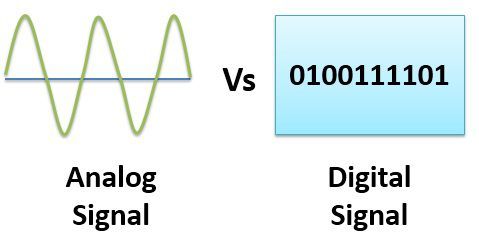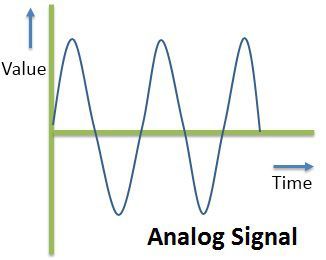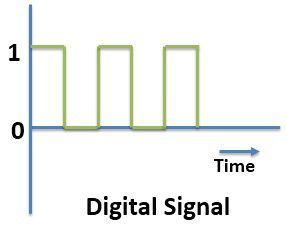 Analog and Digital are the different forms of signals. Signals are used to carry information from one device to another. Analog signal is a continuous wave that keeps on changing over a time period. Digital signal is discrete in nature.
Analog and Digital are the different forms of signals. Signals are used to carry information from one device to another. Analog signal is a continuous wave that keeps on changing over a time period. Digital signal is discrete in nature.
The fundamental difference between analog and digital signal is that analog signal is represented by the sine waves whereas, the digital signal is represented by square waves. Lets us learn some more differences between analog and digital signal with the help of comparison chart shown below.
Content: Analog Vs Digital Signal
Comparison Chart
| Basis for Comparison | Analog Signal | Digital Signal |
|---|---|---|
| Basic | An analog signal is a continuous wave that changes over a time period. | A digital signal is a discrete wave that carries information in binary form. |
| Representation | An analog signal is represented by a sine wave. | A digital signal is represented by square waves. |
| Description | An analog signal is described by the amplitude, period or frequency, and phase. | A digital signal is described by bit rate and bit intervals. |
| Range | Analog signal has no fixed range. | Digital signal has a finite numbers i.e. 0 and 1. |
| Distortion | An analog signal is more prone to distortion. | A digital signal is less prone to distortion. |
| Transmit | An analog signal transmit data in the form of a wave. | A digital signal carries data in the binary form i.e. 0 nad 1. |
| Example | The human voice is the best example of an analog signal. | Signals used for transmission in a computer are the digital signal. |
Definition of Analog Signal
Analog signal is a kind of continuous wave form that changes over time. An anlaog signal is further classified into simple and composite signals. A simple analog signal is a sine wave that cannot be decomposed further. On the other hand, a composite analog signal can be further decomposed into multiple sine waves.
An analog signal is described using amplitude, period or frequency and phase. Amplitude marks the maximum height of the signal. Frequency marks the rate at which signal is changing. Phase marks the position of the wave with respect to time zero.
 An analog signal is not immune to noise hence, it faces distortion and decrease the quality of transmission. The range of value in an analog signal is not fixed.
An analog signal is not immune to noise hence, it faces distortion and decrease the quality of transmission. The range of value in an analog signal is not fixed.
Definition of Digital Signal
Digital signals also carry information like analog signals but is somewhat is different from analog signals. Digital signal is noncontinuous, discrete time signal. Digital signal carries information or data in the binary form i.e. a digital signal represent information in the form of bits. Digital signal can be further decomposed into simple sine waves that are called harmonics. Each simple wave has different amplitude, frequency and phase. Digital signal is described with bit rate and bit interval. Bit interval describes the time require for sending a single bit. On the other hand, bit rate describes the frequency of bit interval.
Digital signal can be further decomposed into simple sine waves that are called harmonics. Each simple wave has different amplitude, frequency and phase. Digital signal is described with bit rate and bit interval. Bit interval describes the time require for sending a single bit. On the other hand, bit rate describes the frequency of bit interval.
A digital signal is more immune to the noise; hence, it hardly faces any distortion. Digital signals are easier to transmit and are more reliable when compared to analog signals. Digital signal has a finite range of values. The digital signal consists 0s and 1s.
Key Differences Between Analog and Digital Signal
- An analog signal represents a continuous wave that keeps changing over a time period. On the other hand, a digital signal represents a noncontinuous wave that carries information in a binary format and has discrete values.
- An analog signal is always represented by the continuous sine wave whereas, a digital signal is represented by square waves.
- While talking of analog signal we describe the behaviour of the wave in respect of amplitude, period or frequency, and phase of the wave. On the other hand, while talking of discrete signals we describe the behaviour of the wave in respect of bit rate and bit interval.
- The range of an anlaog signal is not fixed whereas the range of the digital signal is finite and which can be 0 or 1.
- An analog signal is more prone to distortion in response to noise, but a digital signal has immunity in response to noise hence it rarely faces any distortion.
- An analog signal transmits data in the form of wave whereas, a digital signal transmits the data in the binary form i.e. in the form of bits.
- The best example of an analog signal is a human voice, and the best example of a digital signal is the transmission of data in a computer.
Conclusion
Digital signal is nowadays replacing the analog signal, but analog signal is still best for audio transmission.
Shubham says
Very easy
Bob says
Should include a venn diagram comparing and contrasting the two
your guy bill nye says
this is awesome
Odd Number says
That was a great content. Good, keep it up.
Dhanu says
good info
nisha says
Wonderful points you have mentioned here, I really liked your article, your article is very
petrified me in the learning process and provide
additional knowledge to me, maybe I can learn
more from you, Thank you
Jonas Mwanapabo says
Really helpful information.
Harsh Dudhatra says
It was really very helpful
Shubham Bhosale says
Good information
Adam says
This is so informative guys! Thank you
Wallace103 says
it is awesome
Belbo Baigans says
Nice article dear
Pravin says
Nice….very informative article
Asmit says
Nice information made easy. Hoping for more…
Bilbo Baggins says
Very informative thank you, mam.
LeBronxiiii says
Really nice!
Reyna says
It does make sense……
hayes says
This was a good article.
Caroline says
Your information is accurate.
Mark says
good info
jimbo says
this information was absolute
Jay McKenzie says
wow. this is helpful.
Jannatul Ferdows Mim says
OH! Really like this 🙂
Jim Dougherty says
Very well done. The comparison between analog and digital signals was very easy to understand. Mentioning that analog was still the best method for transmitting audio means that we will be able to use radio receivers that were built decades ago well into the future.
Indi Jonk says
Good article.
David says
Woooow so inspired
Akash rajoria says
It is very simple to learn.
And each point is easy and clear.
described in a good way…
yeet says
very useful!
Haden says
Lucid content….
Uman says
Awesome explanation!
Mary says
I finally understand the basics.
Thank you.
Geenesh Acharya says
Awesome explanation😍😍👌👌👌👌
abdur rahman vendeveluke says
great content 🙂
Reyan Glioover says
Ooh i love this content….
tony says
This was very helpful.
Damptey, Isaac says
That’s really a nice content. I appreciate your efforts.
Raj says
Very good information.
Ankit says
Very helpful information
Emma says
Good info so far but am i the only one from 2020!
Dinesh says
Nice.. Helpful information ☝️☝️
Dinesh says
Nice.. Helpful information ☝️☝️
Jercy Packson says
good article, I know how to use consultation
Thabani says
useful comment, thank you!
Jayden Burns says
Very good
Jayden Burns says
I mean VERY good.
Mondo Cassie says
Yo nice writing you got here! It was very informative
UNKNOWN says
dont take down my comments i will find you
Amongus Balls says
Cool!
Tatsumi says
Thank you
sussybakadaddy says
great information that i dissident need😐😐😐😐😐😐😐😐😐😐😐😐😐😐😐